Have you ever Googled a basic question? Between ads, outdated material, generic content, clickbait, and fun distractions, the amount of information is overwhelming and often unhelpful.
The same applies to many self-directed learning systems and professional development tools — without the clickbait and fun distractions.
The flow may go something like this:
You want to learn something new or further develop a skill.
You somehow manage to set aside time just to learn. Get out your notepad.
You start looking for instructional content and are immediately overwhelmed. There’s too much to choose from. Or the content you found isn’t exactly what you need. A lot of it is vague, doesn’t quite answer your questions, or apply to your role. Or it’s really old…and long…and boring.
Now you are wasting time sifting through pages of content to find a quality course covering the topic you need. And if you’re doing it for professional reasons (and on company time), how do you justify the lack of productivity?
That’s not to say self-directed learning tools don’t have their uses. And in some cases, they are the best and only option.
To help you understand how and when to use these tools effectively — and when to avoid them — we break down the pros, cons, use cases, audiences, and alternatives to self-directed learning systems for enterprise sales teams.
Further reading: The Blueprint for Better Sales Onboarding
What is a self-directed learning system?
A self-directed learning system (SDLS) is a digital library of content covering a variety of topics built for unscheduled, self-motivated learning.
Self-directed learning solutions can be free, cheap, or on the pricier side, and can be totally ungated or require a subscription to log in. And as you can imagine, there’s a ton of them on the internet. Think TED Talks, Masterclass, or LinkedIn Learning.
YouTube could even count as a self-directed learning system, which frames the challenge perfectly: is there a ton of great content on YT? Absolutely. But is there also a ton of trash? Definitely. So how do you find the good stuff? How do you know you can trust the resource or instructor? And how can you make that time you spent finding and absorbing content meaningful to your goals?
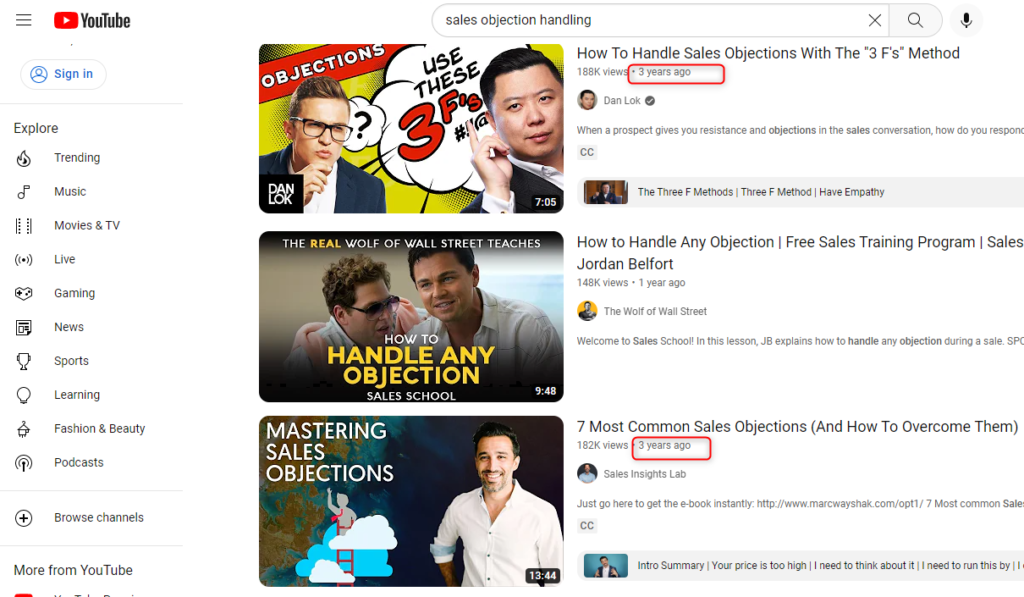
Like all self-directed learning systems, YouTube is helpful for certain audiences and scenarios — but not all.
Do you need to clear a clog in the kitchen sink without calling a plumber? A five-minute YouTube video will do the trick. Now you just saved 300 bucks and learned a new life skill.
Do you need a 60-second demo of how to do something in Salesforce, PowerPoint, or Google Sheets? Great. YouTube has the answer.
Do you want to fall into a two-hour rabbit hole of Conan O’Brien videos or hear every opinion from every guy who ever had a thought? YouTube also has that.
While not as extreme as YouTube where content variety is concerned, other self-directed learning libraries have similar issues.
When to use self-directed learning solutions
For some teams and individuals, self-directed learning is the only kind of learning available given budgetary, time, or other resource constraints.
As indicated above, YouTube is great for quick how-tos for commonly used tools or evergreen business strategies. A free resource like YouTube is perfect for bootstrapped startups or small businesses with limited budget and lots to learn.

The type of content found in TED Talks or Masterclass courses — big ideas, leadership strategies, creative pursuits — is geared toward individuals seeking to better themselves through personal or professional development and can have great impact when it’s self-motivated.
When it comes to enterprise sales teams, access to a self-directed learning platform may be appropriate as a perk, but falls short as a formal training, coaching, or professional development solution for the reasons explored here.
Pros and cons of self-directed learning systems
Looking at self-directed learning software from the perspective of a large enterprise results in the following pros/cons list:
Pros
- Are sometimes packaged with office productivity and collaboration suites
- Learners make their own schedule
- Can be offered as a perk
- Large variety of courses to choose from
- Learners can easily gain skills and certifications that enhance their careers
- Low-stakes, anxiety-free learning (no grades, homework, or performance reviews)
Cons
- Too much content to choose from!
- Lack of specificity and personalization
- No company-specific, proprietary or product information
- No coaching or guidance
- Content not regularly updated
- No accountability (easy to quit courses)
- Learners have to make time for it (perhaps on the clock)
- It is an extra expense with no guarantee of adoption (unless learning is mandated and measured)
The following is an outline of the self-directed learning process from BetterUp. This outline makes it clear the onus is on the learner to assess and meet their own needs in self-directed learning scenarios. In situations where the learner knows exactly what they need to learn, where to learn it, and how to motivate themselves and measure their own progress, self-directed learning can be successful. Any sales or enablement leader can tell you enterprise sales training requires more guidance than that.
- Self-directed learning begins with a person taking the initiative, with or without the help of others.
- Self-directed learning means a person diagnoses what they need to learn.
- Self-directed learning formulates learning goals.
- Self-directed learning identifies human and material resources for learning.
- Self-directed learning chooses and implements appropriate learning strategies.
- Self-directed learning evaluates learning outcomes.
Examples of self-directed learning systems
LinkedIn Learning
LinkedIn Learning, billed by LinkedIn as “a learning experience built for skill builders,” is designed to “empower employees to develop the right skills to grow their career.”
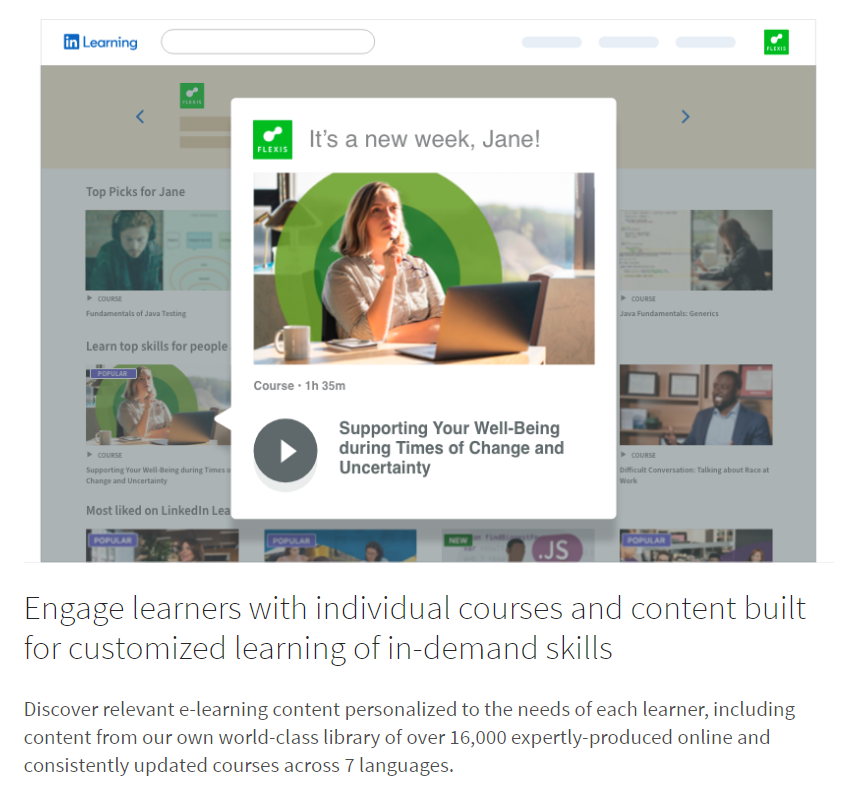
LinkedIn Learning is one of the most common self-directed learning solutions utilized by enterprise employees.
It has four main course categories — business, technology, creative, and certification programs — with “over 4,000 courses covering topics ranging from leadership & business management to Excel & beyond” in the business category alone.
Users can filter content by role and then choose courses that interest them.
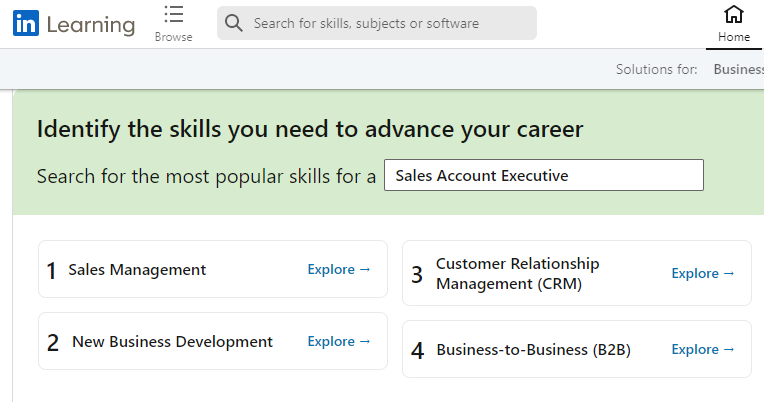
There is some helpful content for enterprise sales teams, but it requires a bit of digging as not all of the content in the library is up to date.
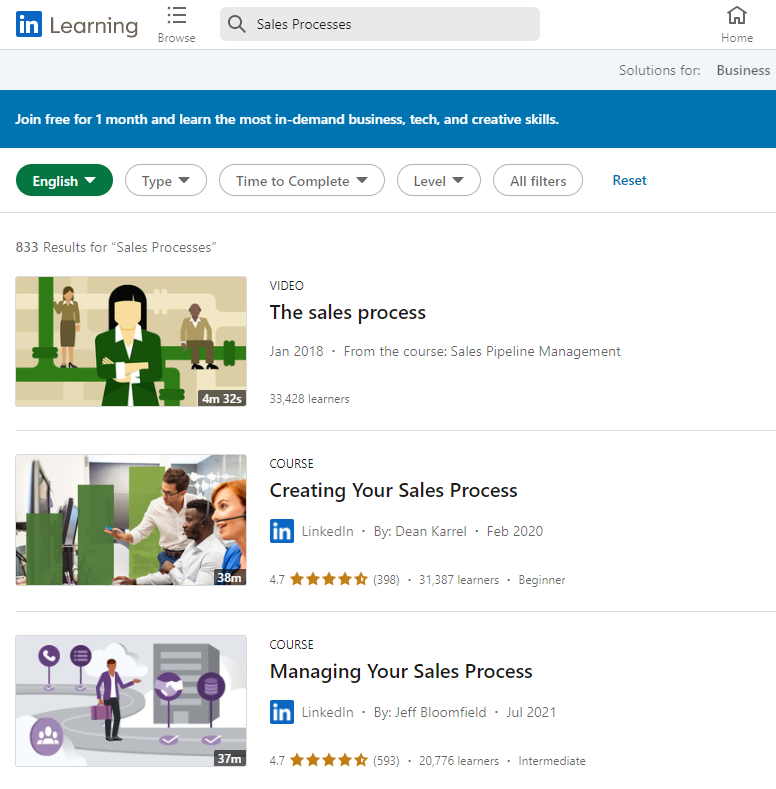
Hubspot Academy
According to their website, Hubspot Academy is “the worldwide leader in free online training for inbound marketing, sales, and customer service professionals… [specializing] in comprehensive certifications, singular topic courses, and bite-sized lessons for professionals looking to grow their career and business.”
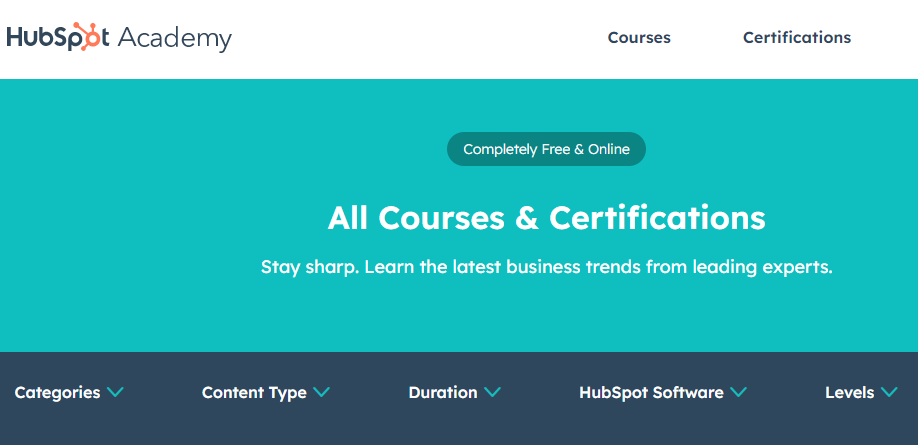
Since Hubspot is a marketing CRM their learning content is largely focused on marketing topics and on their own solution, which they make plain by saying, “As HubSpot’s official learning resource, HubSpot Academy aims to educate users on the HubSpot software, so they can market, sell, and grow an inbound business.”
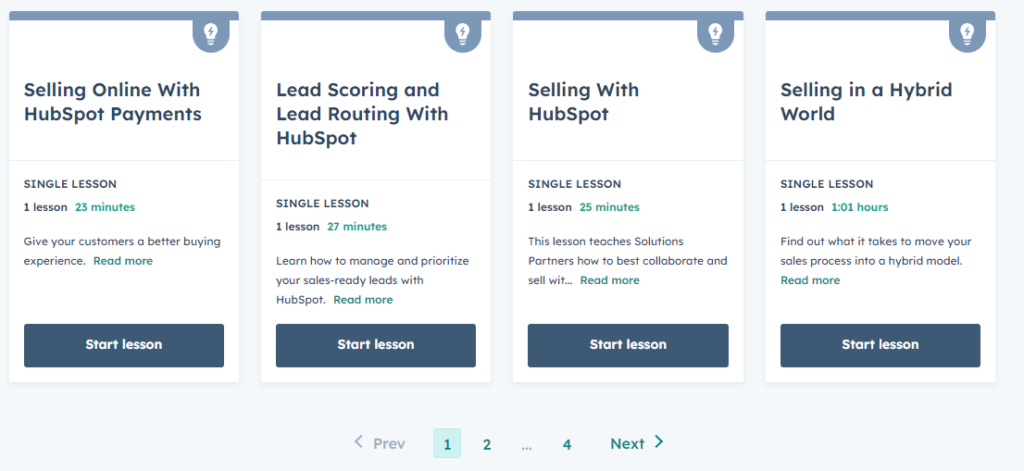
They also offer some sales, web development, and general business courses.
Being a free resource, Hubspot Academy is a great solution for teams and individuals with budgetary concerns who want to develop general marketing, sales, and Hubspot skills. It does require users to share their email to create a free account.
Coursera
Coursera is another population professional development option for teams individuals who want in-depth courses and certifications. Their content is targeted to learners who want to, “Start, switch, or advance” their careers, and offer “more than 5,400 courses, Professional Certificates, and degrees from world-class universities and companies.”
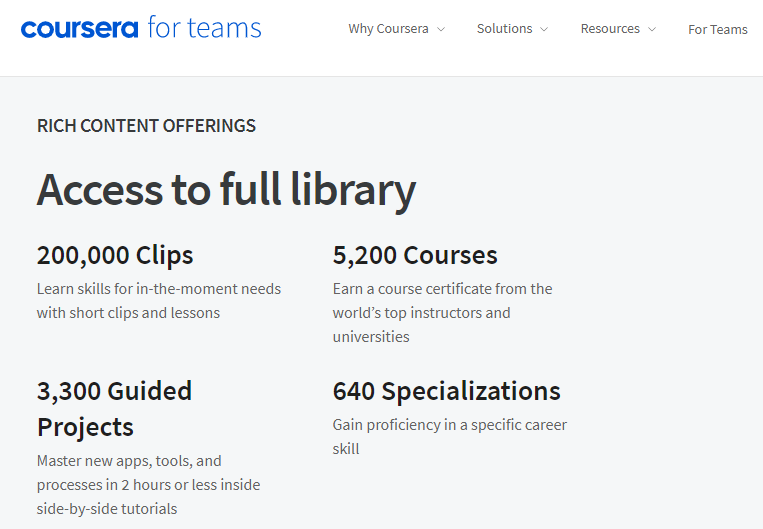
While offering a ton of high-quality content in different areas, Coursera is on the more academic (and pricier) side and may not be the right fit for fast-paced enterprise sales teams looking for more casual or bite-sized content.

Alternatives to self-directed learning systems
Alternatives to self-directed learning systems are, naturally, guided or directed learning systems such as traditional learning management systems (LMS), e-learning software, and sales enablement platforms.
Directed learning systems are systems in which the content and users are both moderated by system administrators. They are gated, have more limited audiences, and therefore have more focused content targeted to their user-base and goals.
While traditional LMS and e-learning platforms are great for industries that require more formal learning, sales enablement platforms are by far the best option for most enterprise sales teams.
See also: The Best Enterprise LMS 2.0 for Training and Knowledge Retention
Sales enablement platforms
Sales enablement is the process of making customer-facing teams able to efficiently move buyers through the sales process to the point where they can make the best buying decision.
Sales enablement platforms (SEPs) help companies implement, scale, and execute their sales enablement strategies. In keeping with the true meaning of sales enablement, these platforms aim to help sellers move prospects through each stage of the buyer’s journey more efficiently.
In addition to managing sales and marketing collateral, these platforms automate or streamline training, coaching, collaboration, communication, and onboarding. They are a form of closed-source learning controlled by Sales Enablement Managers or Learning and Development Leaders designed to upskill employees (particularly sales reps) and tie learning activities back to sales KPIs like opportunities won and pipeline created through dashboards and Scorecards.

SEPs offer a variety of learning modules such as courses, curricula, certifications, just-in-time learning, and quizzes while allowing experts to curate the learning content that is available within the application. This takes the onus of finding the right content off of the learner to save time and have a positive impact on productivity.
Some organizations are even replacing their existing LMS with more modern, comprehensive sales enablement platforms, many of which can import LMS coursework or content from other third-party training creation programs.
The advantages of using sales enablement platforms for sales learning
Personalize (and control) the content
In a self-directed system it is hard to find what you need and actually get the value. Remember the YouTube problem outlined earlier?
For example, if you want to learn PowerPoint skills and go to a self-directed learning library like YouTube you will find at least 14 different courses. How do you know which one is right for you?
With a sales enablement platform, there are dedicated experts who understand exactly what your team members need to know about PowerPoint, find the right PowerPoint course, and add it to the library. If that course becomes outdated, your SEP admins can delete or update the course as needed.
A well-maintained content library eliminates the content curation problem for everyone except the person or people who are supposed to be spending their time on it. They personalize the content, whether it’s custom-made in-house or pulled in from YouTube or another self-directed source, by making it relevant to their team’s specific questions, challenges, and skills.
Content in context
None of this is to say there’s no space for self-directed learning in employee training and professional development. In fact, directed or supervised learning programs can maximize the value of self-directed content — and vice versa — by curating it and putting it in context.
Take LinkedIn Learning, for example. If your company offers employees LinkedIn learning accounts as a perk, they may not use it effectively on their own, but if the right people leverage it in the right way it can add tremendous value.
Sales development reps may not have the time or expertise to manage their own training in a meaningful way — but a Sales Enablement Manager building an onboarding or continuous learning program can browse the content, curate the right courses from LinkedIn Learning, and include them in a more prescriptive program.
Teach proprietary content and information
You also won’t find product or company-specific training in self-directed learning libraries, as they cater to wider audiences and have more generalized topics.
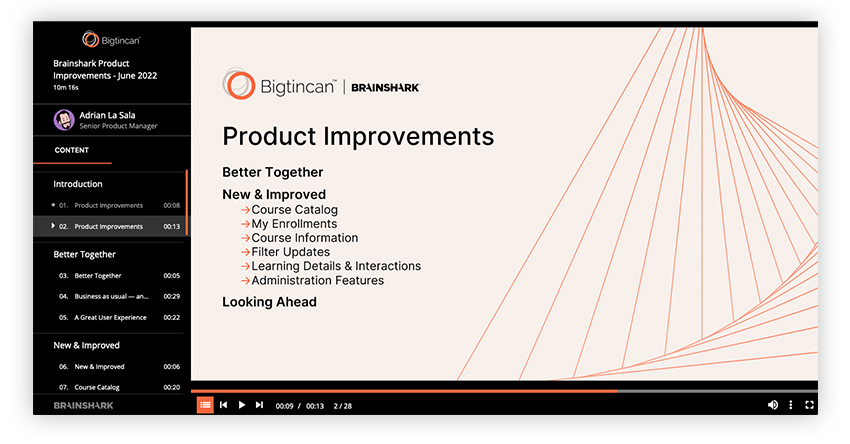
One of the main value propositions of any sales enablement platform is that it helps product and marketing teams keep sales reps up to date on product and brand information so the company presents a unified message.
Build learning time into work
If it matters to your manager you’ll do it, otherwise learning is not prioritized. – Adrian La Sala, Senior Product Manager of Content Authoring & Learning Initiatives at Bigtincan
Another downside or reason for low adoption and completion rates of self-directed learning is that there’s no clear end goal or accountability. Being self-driven, it is easy to simply quit the course halfway through with no repercussions.
Sales enablement platforms have learning paths controlled by admins or AI to walk sales reps through the exact courses they need, use a combination of short videos and materials that hold their attention, allow them to sprinkle in regular learning throughout their workweek, and use reporting to track learning progress and tie it back to job performance.
The learning becomes part of the work day and has a clear goal to motivate employees to stick with it.
Provides coaching and guidance
Alongside product knowledge transfer, personalized sales coaching is another tenet of sales enablement platforms.
Studies show that without the coaching aspect, there is lower knowledge retention in self-directed learning. The following are conclusions are from a 2019 academic study conducted among clinical nursing staff following a self-directed learning program that included coaching:
- “Self-directed learning requires a coach to assist and guide students.
- Effective coaching involves learning from interactions with students, cooperation, exchanging learning materials, and providing encouragement.
- Coaching has been found to be a good approach to successfully lead students’ self-directed learning.
- The coach in self-directed learning prepares and motivates students, and helps them set learning objectives, establish learning strategies, manage learning resources, and evaluate their learning results during the self-directed learning process.
- Therefore, instruction of faculty members in self-directed learning and coaching methods is very important.”
Information overload is a real problem — and people are just plain busy. If you want your sales staff to develop the right knowledge and skills to be effective in their roles, they need quality, curated learning content that is easy to access and comes with clear goals.
Get a more comprehensive overview of the uses and benefits of sales enablement in The Essential Guide to Sales Enablement.
